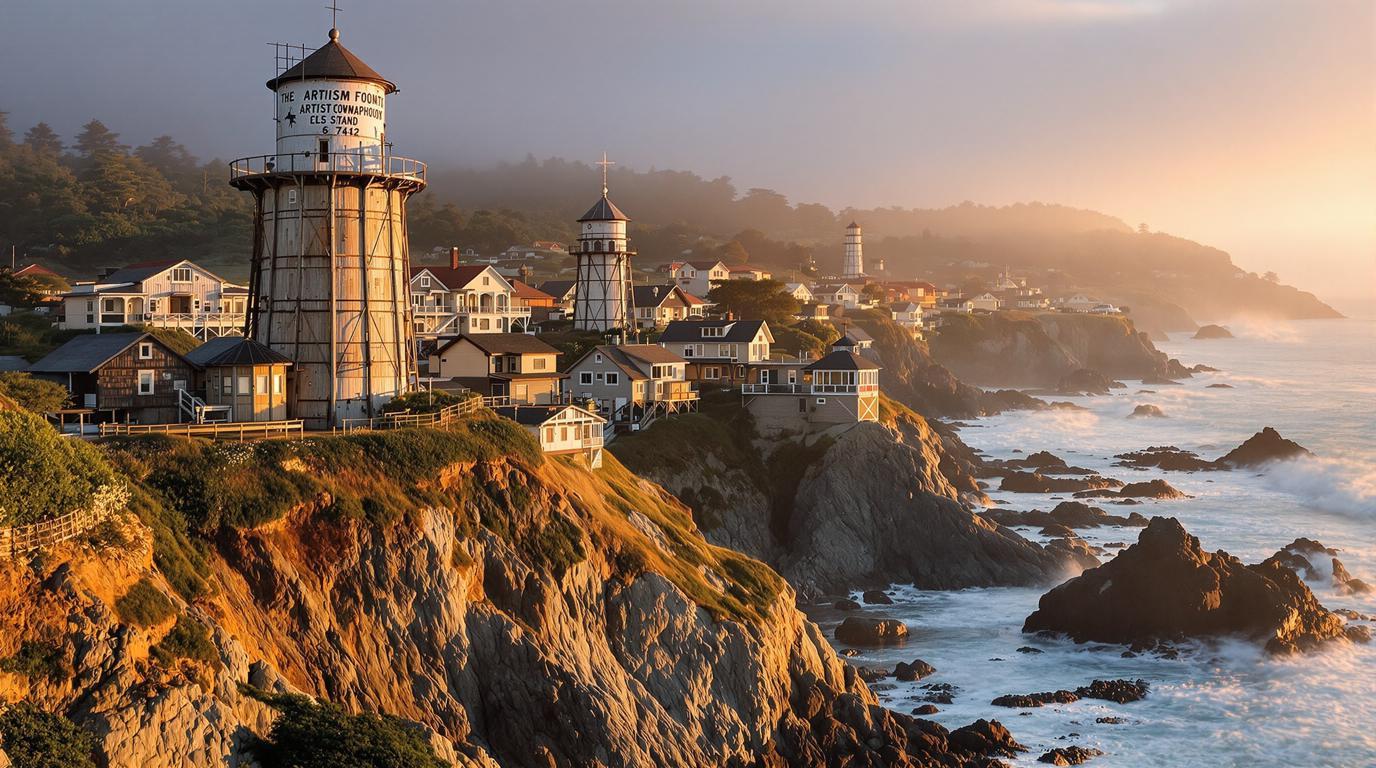I felt the weight of history when the gilded gates of Mendocino’s century-old water tower first creaked open for me, revealing not a tourist attraction but the workshop of Eleanor Gaines, a 73-year-old woodcarver whose family has occupied this space since California’s logging boom. “Most visitors rush past to the cliffs,” she confided, running weathered fingers along a half-finished redwood osprey, “but this tower has witnessed more of Mendocino’s soul than any postcard view.”
Where the Pacific whispers centuries-old secrets
Mendocino Village clings to Northern California’s rugged headlands like an artist’s afterthought – all Victorian architecture and salt-weathered charm. Established in 1852 as a logging settlement, its New England aesthetic stands bizarrely transplanted against dramatic Pacific cliffs, creating a visual contradiction that’s captivated filmmakers for decades.
Unlike the manicured perfection of Carmel or the boisterous energy of Santa Cruz, Mendocino maintains a deliberate remoteness. Nearly three hours north of San Francisco, this isolation has preserved both its architectural heritage and an artistic community that arrived in the 1960s and never quite left.
“We’re caught between centuries here,” local herbalist Martin Keller told me over tea in his garden apothecary. “The fog preserves everything – buildings, traditions, eccentricities.”
Discovering hidden pockets of authentic coastal magic
The secret passageway beneath Mendocino headlands
Below the Presbyterian church’s white steeple, a narrow dirt path winds down to a sea cave system most visitors never glimpse. At low tide, locals access a sheltered cove ringed by natural arches where abalone shells create a mosaic at the water’s edge. Timing is critical – the pathway disappears completely during high tide, a reminder of nature’s dominance here.
Park at the corner of Lansing and Little Lake streets and follow the unmarked trail beside the cemetery. Bring a flashlight if you visit after 4 PM – the cave entrance becomes nearly invisible as shadows lengthen.
The woodland spirits of Montgomery Grove
Three miles inland, artist Howard Montgomery has spent 40 years creating a sculpture garden that blurs boundaries between art and forest. Dozens of wooden figures emerge organically from the redwood understory – some obvious, others revealing themselves only when light filters through the canopy at specific angles.
Unlike the polished galleries in town, Montgomery accepts no payment, merely requesting visitors sign his leather-bound journal. His sculptures incorporate fallen branches, leaving living trees untouched in a meditation on impermanence that feels almost sacred.
Savoring the intersection of land and sea
At Tidal Harvest, housed in an unassuming blue cottage on Albion Street, Chef Renata Moore serves what she calls “fog-to-fork” cuisine. Her sea urchin custard topped with foraged spruce tips arrives in abalone shells collected during morning dives, embodying Mendocino’s environmental intimacy.
The five-table restaurant operates without fixed hours – Moore opens when local fishermen return with their catch and closes when food runs out. Prices reflect fair compensation throughout the supply chain rather than luxury markup, with Moore personally introducing each dish’s origin story.
Navigating Mendocino with insider wisdom
Timing your visit for authentic experiences
Mid-week in May or September offers perfect balances of weather and solitude. The renowned rhododendron bloom transforms the headlands each May, while migrating gray whales frequently venture unusually close to shore during spring journeys north. Weekends bring an influx from the Bay Area, shifting the village’s character noticeably.
Accommodation secrets
Skip the obvious B&Bs for Lighthouse Keeper’s Cottage, a historically preserved structure available for overnight stays through the Mendocino Historical Society. The society maintains three heritage properties that provide authentic experiences while funding preservation efforts. Book six months ahead for the Keeper’s Cottage – its single room books solidly through summer.
Carrying Mendocino’s rhythms homeward
As I departed along Highway 1, Mendocino receded in my rearview mirror like a lucid dream – a place where time operates by different rules and the boundary between natural and human worlds thins appreciably. The village doesn’t reveal itself to those merely passing through, but rewards the patient traveler who abandons agendas in favor of serendipity, much like this medieval French village that clings dramatically to a 120-meter cliff face, demanding visitors slow their pace to discover its secrets.
True Mendocino reveals itself in quiet moments – morning fog lifting from weathered gravestones, the precise moment sea urchin meets spruce tip on your tongue, or finding yourself alone in Howard’s grove as shifting light transforms wooden figures from invisible to inevitable. Like this hidden French cascade that emerges from solid rock, Mendocino’s most profound experiences remain concealed until you venture beyond the obvious paths.
For travelers seeking authenticity over performance, this coastal village offers what increasingly few destinations can: a place still becoming itself, much like this UNESCO treasure in medieval France that balances preservation with living culture. Here, you’re not merely witnessing history – you’re participating in its unfolding story.
